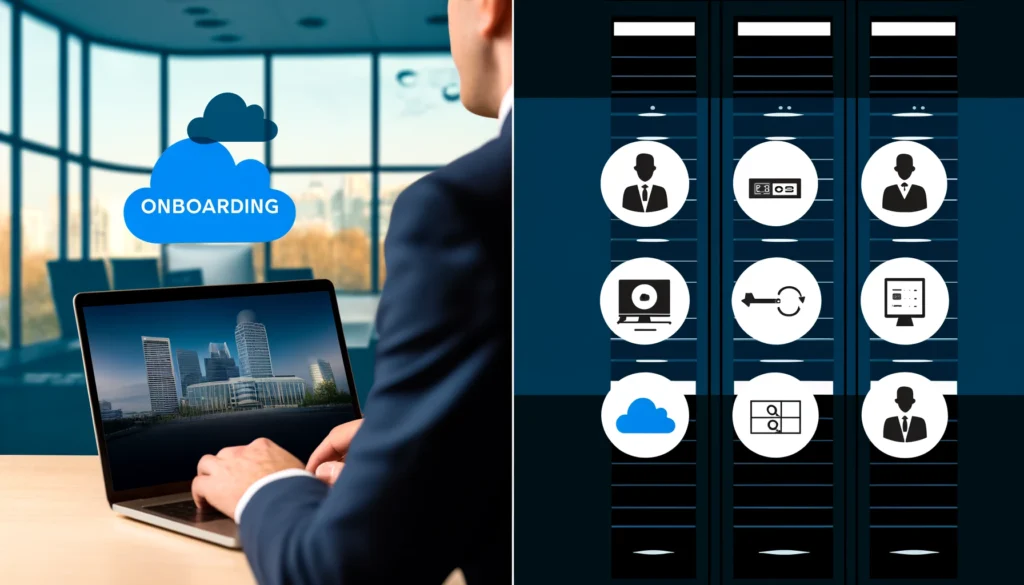Effective employee onboarding is a critical process for any organization, but it holds particular significance for IT professionals tasked with ensuring that new hires are seamlessly integrated into the company’s systems and culture. Given the complexities involved in IT environments, onboarding software must not only streamline the process but also address stringent security requirements, offer robust customization capabilities, and provide flexible deployment options.
This article aims to provide IT professionals with a comprehensive understanding of the key features to look for in employee onboarding software. We will delve into essential security measures, explore the customization capabilities necessary to tailor onboarding processes to specific organizational needs, and compare the benefits of cloud-based versus on-premise solutions. By focusing on these critical aspects, IT professionals can make informed decisions that enhance the onboarding experience while ensuring compliance and security.
Through this guide, we aim to resolve common issues and provide practical solutions for IT professionals deeply engaged in HR and recruiting solutions. We understand the importance of expert advice in navigating the complex landscape of employee onboarding software, and we are committed to delivering valuable insights that align with the specific needs of our audience.
Security Features in Employee Onboarding Software
Importance of Security in Onboarding Software
In today’s digital age, the security of employee onboarding software is paramount. As IT professionals know, the onboarding process involves the transfer and storage of sensitive personal information, including social security numbers, bank details, and employment contracts. Ensuring this data is protected against breaches and unauthorized access is crucial to maintaining trust and compliance with regulatory standards.
Essential Security Features
Data Encryption
Data encryption is a fundamental security feature that protects sensitive information by converting it into a code that only authorized parties can decode. There are two main types of encryption to consider:
- Encryption at Rest: Protects data stored on servers or other storage devices. This ensures that even if physical devices are compromised, the data remains secure.
- Encryption in Transit: Secures data as it travels across networks, preventing interception by unauthorized parties. This is crucial for protecting data during the onboarding process, particularly when using cloud-based solutions.
Implementing both types of encryption is essential to safeguard employee data throughout the onboarding process.
Access Controls and User Permissions
Access controls and user permissions are vital for ensuring that only authorized personnel can access sensitive information. Key components include:
- Role-Based Access: Assigns permissions based on the user’s role within the organization, limiting access to only the information necessary for their job functions.
- Multi-Factor Authentication (MFA): Adds an extra layer of security by requiring users to provide two or more verification factors to access the system. This can include something they know (password), something they have (security token), or something they are (biometric verification).
These measures significantly reduce the risk of unauthorized access and ensure that employee data is protected.
Compliance and Regulatory Requirements
Compliance with regulatory standards is a critical aspect of security for onboarding software. IT professionals must ensure that the software adheres to regulations such as:
- GDPR (General Data Protection Regulation): Applies to organizations operating within the EU or dealing with EU citizens’ data, requiring strict data protection measures.
- HIPAA (Health Insurance Portability and Accountability Act): Pertains to healthcare organizations, mandating the protection of personal health information.
Onboarding software should facilitate compliance by offering features like data anonymization, consent management, and detailed audit logs.
Regular Security Audits and Penetration Testing
Routine security audits and penetration testing are essential for identifying and addressing vulnerabilities within the onboarding system. These practices involve:
- Security Audits: Comprehensive evaluations of the software’s security posture, conducted either by third-party experts or internal teams. These audits should be performed regularly to ensure ongoing compliance and security.
- Penetration Testing: Simulated cyberattacks carried out by ethical hackers to identify potential weaknesses in the system. This proactive approach helps to uncover and fix vulnerabilities before they can be exploited by malicious actors.
Best Practices for Ensuring Security
In addition to the above features, IT professionals should implement best practices to enhance security, including:
- Employee Training and Awareness Programs: Educate employees about security risks and best practices for safeguarding sensitive information.
- Regular Updates and Patch Management: Ensure that the software is kept up-to-date with the latest security patches and updates to protect against known vulnerabilities.
By prioritizing these security features and best practices, IT professionals can ensure that their employee onboarding software provides a secure environment for new hires, safeguarding sensitive information and maintaining compliance with regulatory standards.

Customization Capabilities of Onboarding Systems
Importance of Customization in Onboarding Processes
Customization in onboarding software is essential for tailoring the onboarding experience to meet the specific needs of an organization. For IT professionals, this means creating workflows and processes that align with the technical requirements and unique structure of their teams. Customization enhances the onboarding experience, making it more relevant and engaging for new hires, and helps streamline administrative tasks for HR and IT departments.
Key Customization Features
Customizable Workflows
Customizable workflows allow organizations to design onboarding processes that fit their specific requirements. This feature is particularly beneficial for IT departments, which may need to incorporate various technical training modules, security clearances, and equipment provisioning steps. Key aspects include:
- Role-Specific Onboarding: Create tailored workflows for different job roles, ensuring that each new hire receives relevant training and resources.
- Integration with Other Systems: Seamlessly integrate with other HR and IT systems, such as payroll, learning management systems (LMS), and identity management systems, to automate and streamline processes.
Branding and Personalization
Maintaining brand consistency and providing a personalized experience can significantly enhance the onboarding process. Onboarding software should offer:
- Customizable Portals and Dashboards: Design onboarding portals that reflect the company’s branding, including logos, color schemes, and messaging. This creates a cohesive experience that aligns with the organization’s identity.
- Personalized Content: Deliver personalized onboarding content based on the new hire’s role, department, and location. This can include welcome messages, training materials, and task lists tailored to the individual’s needs.
Integration Capabilities
Integration capabilities are crucial for ensuring that onboarding software can communicate effectively with other tools and systems used by the organization. Important considerations include:
- API Availability: Ensure the software provides robust APIs that allow for seamless integration with existing systems, such as HR management systems (HRMS), directory services, and IT asset management tools.
- Ease of Integration: The software should be easy to integrate, minimizing the need for extensive custom development. Look for solutions that offer pre-built connectors for commonly used applications.
Reporting and Analytics
Customizable reporting and analytics features are vital for tracking the effectiveness of onboarding processes and making data-driven decisions. Key features include:
- Customizable Reports: Generate reports that provide insights into various aspects of the onboarding process, such as completion rates, time-to-productivity, and employee feedback.
- Data-Driven Decision Making: Use analytics to identify bottlenecks and areas for improvement in the onboarding process. This can help optimize workflows and enhance the overall onboarding experience.
Case Studies/Examples of Effective Customization
Real-world examples can illustrate the benefits of effective customization in onboarding systems. Consider the following scenarios:
- Tech Company A: Implemented a role-specific onboarding workflow that included detailed technical training modules for new developers, resulting in a 30% reduction in time-to-productivity.
- Enterprise B: Customized their onboarding portal to reflect their brand identity and integrated it with their LMS and payroll systems, leading to a more cohesive and efficient onboarding process.
These examples highlight how customization can lead to tangible improvements in onboarding efficiency and effectiveness.
By leveraging the customization capabilities of onboarding software, IT professionals can create tailored, engaging, and efficient onboarding processes that meet the unique needs of their organizations. This not only enhances the new hire experience but also improves overall productivity and satisfaction.

Onboarding Software: Cloud vs. On-Premise Solutions
Overview of Deployment Options
Choosing the right deployment option for onboarding software is a crucial decision for IT professionals. Both cloud-based and on-premise solutions offer distinct advantages and challenges. Understanding these differences is essential for selecting a solution that aligns with the organization’s needs, resources, and long-term goals.
Advantages and Disadvantages
Cloud-Based Solutions
Advantages:
- Scalability: Cloud-based onboarding software can easily scale to accommodate the growing needs of an organization. This flexibility allows businesses to adjust their usage and capacity without significant investment in additional hardware or infrastructure.
- Cost-Effectiveness: Cloud solutions typically operate on a subscription basis, reducing the need for large upfront capital expenditures. This model can be more affordable for smaller organizations or those with fluctuating onboarding demands.
- Ease of Updates: Cloud providers manage software updates and maintenance, ensuring that the latest features and security patches are automatically applied. This reduces the burden on internal IT teams and ensures the software remains up-to-date.
Disadvantages:
- Dependency on Internet Connectivity: Cloud-based solutions require a reliable internet connection. Any disruption in connectivity can impact access to the onboarding system, potentially delaying onboarding processes.
- Potential Security Concerns: While reputable cloud providers implement robust security measures, data stored in the cloud may still be perceived as more vulnerable to breaches compared to on-premise solutions. Organizations must carefully evaluate the security protocols of their chosen cloud provider.
On-Premise Solutions
Advantages:
- Greater Control: On-premise solutions offer IT professionals complete control over the software environment, including customization, security settings, and data management. This can be particularly important for organizations with strict regulatory requirements.
- Enhanced Security: Data stored on-premise can be better protected against external threats, as the organization has direct oversight of security measures. This can alleviate concerns about data breaches and unauthorized access.
- Compliance Ease: For organizations subject to stringent regulatory requirements, on-premise solutions can simplify compliance by ensuring that data storage and processing remain within the organization’s control.
Disadvantages:
- Higher Upfront Costs: On-premise solutions require significant initial investment in hardware, software, and infrastructure. This can be a barrier for smaller organizations or those with limited budgets.
- Maintenance Responsibilities: Internal IT teams are responsible for maintaining and updating on-premise software, which can be resource-intensive. This includes managing security patches, software upgrades, and system performance.
Factors to Consider When Choosing a Deployment Model
Organizational Size and Structure
The size and structure of an organization can significantly influence the choice between cloud-based and on-premise solutions. Larger organizations with complex IT environments and substantial resources may prefer on-premise solutions for greater control and customization. Conversely, smaller organizations or those with limited IT infrastructure may benefit from the scalability and cost-effectiveness of cloud-based solutions.
Security and Compliance Needs
Security and compliance requirements are paramount considerations. Organizations handling highly sensitive data or subject to strict regulatory standards (e.g., healthcare, finance) may opt for on-premise solutions to maintain direct control over security measures. Cloud-based solutions, however, can also meet high security standards if provided by reputable vendors with robust compliance certifications.
Cost and Resource Allocation
Total Cost of Ownership (TCO) is a critical factor. While cloud-based solutions typically have lower upfront costs and predictable subscription fees, on-premise solutions involve higher initial investments but may offer long-term cost savings for larger organizations. Additionally, consider the internal resources available for maintaining and supporting the chosen solution.
Future Scalability and Flexibility
Long-term scalability and flexibility are essential for growing organizations. Cloud-based solutions offer inherent scalability, allowing businesses to quickly adapt to changing needs. On-premise solutions, while offering control, may require significant investment to scale up. Hybrid models combining both cloud and on-premise elements can provide a balanced approach, leveraging the benefits of both deployment options.
Hybrid Solutions
Hybrid solutions, which combine elements of both cloud-based and on-premise deployment, can offer a balanced approach for organizations seeking flexibility and control. These solutions allow critical data and applications to be maintained on-premise while leveraging the scalability and cost-effectiveness of the cloud for other functions.
By carefully evaluating these factors, IT professionals can select an onboarding software deployment model that aligns with their organization’s specific needs, ensuring an efficient, secure, and scalable onboarding process.

Conclusion
Summary of Key Points
In this comprehensive guide, we explored the critical aspects of employee onboarding software, focusing on security features, customization capabilities, and deployment options. Here’s a quick recap:
- Security Features:
- Importance of data encryption, both at rest and in transit.
- Essential access controls and user permissions, including role-based access and multi-factor authentication.
- Compliance with regulatory standards such as GDPR and HIPAA.
- Regular security audits and penetration testing to identify and address vulnerabilities.
- Customization Capabilities:
- Customizable workflows tailored to specific job roles and departmental needs.
- Branding and personalization to enhance the onboarding experience.
- Integration capabilities with other HR and IT systems.
- Robust reporting and analytics to track and optimize onboarding processes.
- Deployment Options:
- Advantages and disadvantages of cloud-based solutions, emphasizing scalability, cost-effectiveness, and ease of updates.
- Pros and cons of on-premise solutions, focusing on greater control, enhanced security, and compliance ease.
- Key factors to consider, including organizational size, security and compliance needs, cost, resource allocation, and future scalability.
- The potential benefits of hybrid solutions combining cloud and on-premise elements.
Final Recommendations for IT Professionals
For IT professionals, selecting the right employee onboarding software involves a careful evaluation of organizational needs and resources. Here are some final recommendations:
- Prioritize Security: Ensure that the onboarding software includes robust security features, such as encryption, access controls, and compliance tools. Regularly conduct security audits and penetration testing to maintain a secure environment.
- Embrace Customization: Look for software that offers extensive customization capabilities. Tailor onboarding workflows to specific roles, integrate with other systems, and use personalized content to enhance the onboarding experience.
- Evaluate Deployment Options: Consider the pros and cons of cloud-based and on-premise solutions. Assess your organization’s size, security needs, budget, and long-term growth plans. Hybrid solutions can offer a balanced approach, providing flexibility and control.
- Stay Informed: Keep up with the latest trends and developments in onboarding software. Regularly review your onboarding processes and software capabilities to ensure they continue to meet your organization’s evolving needs.
Call to Action
Now that you have a thorough understanding of the essential features and considerations for employee onboarding software, it’s time to take action. Evaluate your current onboarding system, identify areas for improvement, and explore solutions that align with your organization’s specific needs.
Share your experiences and insights on onboarding software with your peers and colleagues. Engaging in discussions can help you gain new perspectives and stay informed about best practices and innovative solutions in the industry.
By making informed decisions and implementing the right onboarding software, you can enhance the onboarding experience, improve security, and ensure a smooth transition for new hires into your organization.





